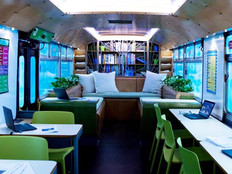Nothing but Nettops?: Are the Inexpensive Desktop PCs The Ideal Choice for Classrooms?
This new breed of compact computing devices is best suited to basic day-to-day tasks.
How do you get a computer into every student's hands without totally blowing the budget?
Most K–12 IT managers know this question all too well. They've answered it in a variety of ways, with some distributing low-cost netbooks to each student and others delivering applications via thin clients or virtual desktops.
This new breed of compact computing devices is best suited to basic day-to-day tasks.
How do you get a computer into every student's hands without totally blowing the budget?
Most K–12 IT managers know this question all too well. They've answered it in a variety of ways, with some distributing low-cost netbooks to each student and others delivering applications via thin clients or virtual desktops.
Over the past year, a new option has emerged: the nettop – a desktop PC that's as inexpensive as a netbook and as small as a thin client, but without the complexity or cost of a thin client or virtual infrastructure. Nettops such as Lenovo's IdeaCentre Q100, Acer's Veriton N260G and those in Asus' Eee Box series are about the size of a hardcover novel, yet offer features comparable to a desktop PC.
The Veriton N260G, for example, has 2 gigabytes of RAM, a 160GB hard drive and Microsoft Windows XP. Both it and the Eee Box PC EB1501 employ ultra-efficient Intel Atom processors, which reduce energy consumption by up to 70 percent compared with desktop PCs, according to Asus.
At $300 to $600, most nettops are in the same price range as netbooks, but because they're not portable, they're less likely to be lost, stolen or damaged from being dropped. Plus, unlike netbooks, nettops don't have batteries that require charging.
Another plus: You can tether a nettop to a desk for security and mount it to a full-size monitor, which is easier on students' eyes than a tiny netbook screen, says Rob Enderle, principal analyst for Enderle Group. “K–12 has a big problem with theft and damage, and schools don't have a lot of money to deploy new products,” he says. For many of them, “nettops may be the better solution.”
Empty Net
So why aren't more schools using these devices?
Although nettops are adequate for web surfing and other everyday computing tasks, they usually can't handle processor- or graphics-intensive design software. And as is the case with any desktop solution, deploying and managing hundreds of individual nettops can be cumbersome.
“Nettops are really good for basic functions like surfing the web and playing YouTube videos,” says Charles Kanavel, director of technology for the Campbell Union High School District in San Jose, Calif. “Anything more complicated than that – running Adobe Creative Suite 5, for example – and you need a more capable machine.”
For these reasons, Campbell Union chose a desktop virtualization solution that lets Kanavel and his six-person staff maintain and upgrade all student systems at the district's six schools from a central location.
Fresno Unified School District, meanwhile, found its one-to-one solution in HP Mini netbooks. Over the past two years, the California district has purchased more than 12,000 of them, says Chief Technology Officer Kurt Madden.
“We believe that, in the future, everyone will be carrying a laptop, a netbook or a slate tablet wherever they go,” Madden says. “We wanted [the district's 73,000-plus students] to learn with that model. That's why we went with netbooks over nettops.”
Still, nettops can be a cost-effective one-to-one approach for districts that lack the resources to manage more sophisticated networked environments – especially for younger students.
“I think nettops are a great way to get computers into the classroom so teachers can more easily create technology-infused lessons,” says Maria Markatos, technology coordinator for Technology High School in Newark, N.J. “But high school students use video and editing tools for some projects and need more robust machines. Nettops shouldn't totally replace a standard PC or Mac.”
Nettop Shop Talk
Here are some questions IT managers should ask when considering nettops:
- Will students need to view high-definition video? Nettops offering an Nvidia Ion graphics processor and an HDMI port, such as Lenovo's new IdeaCentre Q150, may offer smoother performance when displaying HD images.
- Will the devices be running cloud-based or local apps? If everything's local, the nettop will need to have enough storage and processing muscle to handle it. A 1.66-gigahertz Atom processor with 2GB of RAM and a 160GB hard drive is a solid minimum configuration.
- How strong is your wireless infrastructure? For nettops such as the Asus Eee Box, which offers 802.11n networking, you'll need to ensure adequate Wi-Fi coverage throughout your campus.
- Will students be editing video or working with large graphics files? If so, a nettop is probably not the best choice because it generally lacks the processing power necessary to handle complex graphics.








